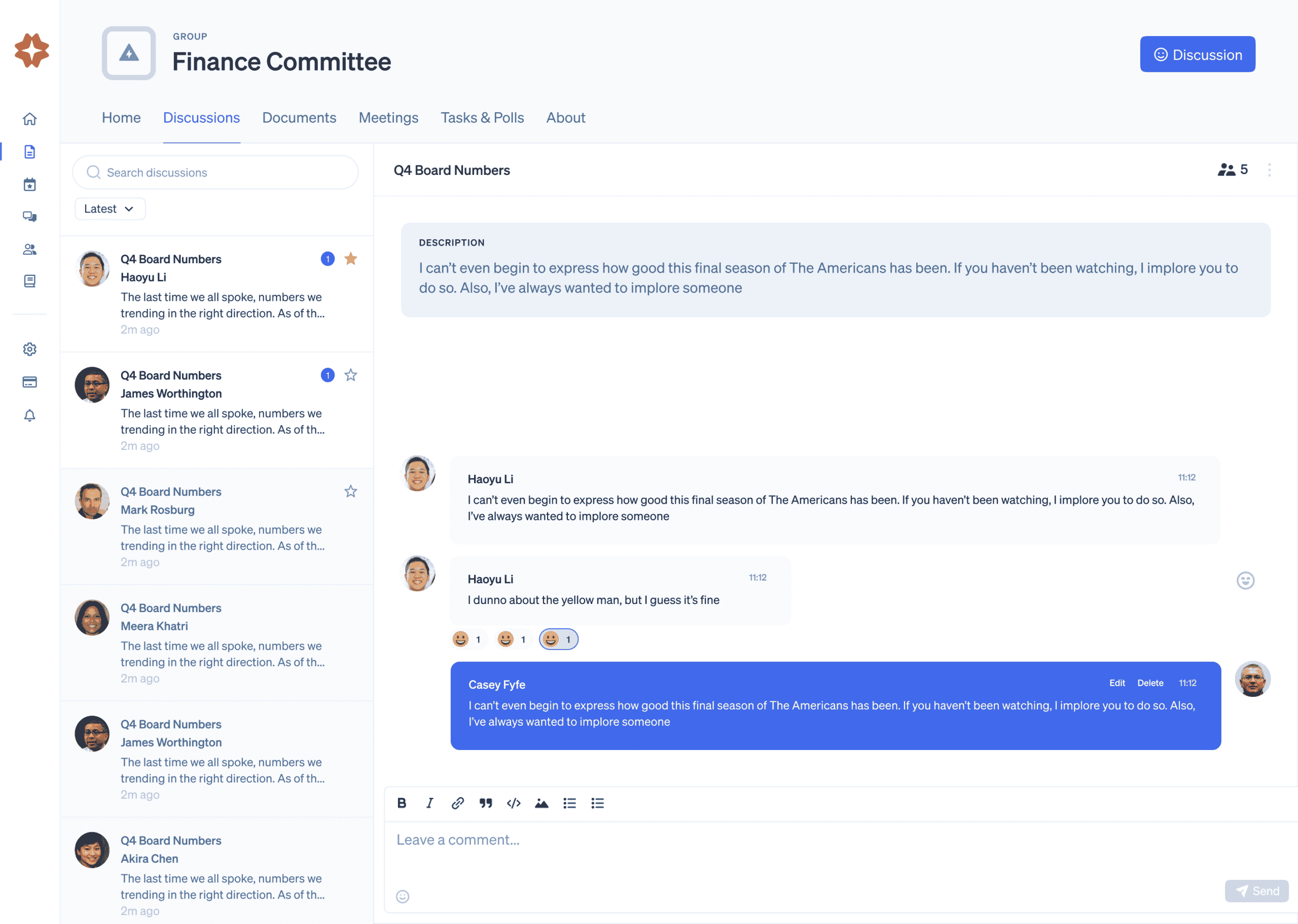Effective committee management remains one of the fastest ways a board can turn strategic intent into measurable action. Yet many nonprofits still struggle with siloed communication, outdated documents, and members who arrive unprepared. This updated guide revisits the fundamentals and layers in 2025 best practices so your committees stay focused, compliant, and impact-driven.
In this article, you’ll discover:
- What is a Committee?
- What is the Purpose of a Committee?
- What’s the Importance Of Committee Management?
- Types Of Management Committees
- Roles And Responsibilities of Committee Members
- Roles And Responsibilities of Management Committees
- Management Committee Vs Executive Committee
- Committee Management Software
What is a Committee?
A committee is a group of individuals within an organization who are designed to handle specific tasks or focus areas. Committees are often formed to address ongoing concerns, special projects, or strategic initiatives. In the nonprofit world, committees play a crucial role in making sure that an organization’s goals are met efficiently and effectively. By delegating responsibilities to smaller groups, boards can ensure that specialized knowledge and skills are brought to the forefront, fostering more focused decision-making and better resource allocation.
Pro tip: Publish each committee’s charter and meeting cadence on your board portal so members can self-select into the work that matches their skills.
What is the Purpose of a Committee?
The purpose of a committee is to support the board or leadership team by handling specific tasks or areas that require dedicated attention. Committees often take on detailed work, such as research, planning, or problem-solving, and bring recommendations to the larger board for consideration. They help streamline decision-making processes, allowing the board to focus on broader, strategic matters. By leveraging the expertise of committee members, organizations can be more effective in achieving their goals and fulfilling their missions.
What’s the Importance of Committee Management?
Committee management benefits the function of the committee and the board as a whole. Well-managed committees are informed of meeting agendas well in advance so that they come prepared to the meeting, having read the previous meeting’s minutes, and are ready to discuss the agenda items. They also remain focused and on-task for the duration of the meeting. Providing committee members with the support and solutions they need to enable this preparedness level takes intentional planning and structure.
Committee management can happen in a variety of ways. One of the most common solutions is a paper and electronic communication combo. Paper agendas are mailed out prior to the meeting, are available on-sight, and the committee is reminded of the time, date, and agenda via email. While this enhances communication, this approach also places a heavy burden on the committee members to keep track of pertinent information. Papers are frequently misplaced, and emails can also get lost in inboxes full of other information.
Many boards and committees are attempting to take their committee management strategy fully digital. However, this strategy can also be cumbersome and difficult to navigate. This is especially true if the information is housed in many digital sources like email, cloud services, etc. It can lead to unprepared committee members and unproductive meetings.
The Four Core Types of Board Committees
What are the 4 types of committees? Although individual committees have many different names, there are four different types of board committees in general:
- An ad hoc committee is usually temporary and created for a very specific purpose. For instance, decorating or bake sale committees are common examples of ad hoc committees. These are short-term opportunities, however, they are very common and still important.
- A constitutional committee is meant to advise the board of directors on issues related to the policies and procedures of an organization, as well as other ‘constitutional’ issues otherwise known as governance.
- An advisory committee is comprised of individuals who bring their expertise on a specific topic and advise the board based on their experience.
- A joint committee may include members of the community or members of a board in a different organization that have come together for a common purpose or to advance a relationship.
Although there may be many different names for types of board committees in corporate governance and types of committees in nonprofit organizations, all committees fall into one type from the above categories. Types of management committees could be constitutional or advisory, however, it is likely to vary from board to board.
Role And Responsibilities Of Committee Members
The roles and responsibilities of committee members can vary by committee. It is usually dependent on the committee’s role within the organization. For example, the planning committee roles and responsibilities would likely be different from the budget committee’s roles and responsibilities. It can be beneficial to create a “Roles & Responsibilities of Committee Members” PDF to help keep everyone on track.
In general, here are a few common roles of members in a meeting:
- Read and understand the agenda. The agenda is what determines the course of a meeting and is often crafted with the intention of priority and what time allows.
- Take action on agenda items. Committees are created to accomplish tasks. It is the responsibility of committee members to read the agenda, understand it, make motions, and then follow through with the resolutions of their actions.
- Appointing new committee members. It is common for committee members to serve “terms” and have a term limit. It’s important to always have new committee members in place to preserve the committee’s purpose.
- Support the action and efforts of the committee overall. As previously stated, the committee exists for a reason. It is the responsibility of that committee to oversee and advance the organization’s overall mission.
A recurring question about committee membership is about the legal responsibilities of committee members. Every committee member and board must understand the local, state, and federal laws surrounding board responsibilities regarding their type of organization. In the case of all organizations, particularly those that maintain non-profit status, all tax filings must be completed fully and turned in on time.
You may lose your status if you do not renew your organization’s tax-exempt status with an IRS Form 990. For-profit boards should also understand the legal consequences associated with overpaying or underpaying staff, supporting political causes with organizational funds, and the misuse of organizational funds in general.
Management Committee Roles And Responsibilities
You might be wondering what the role of a committee in an organization is. Management committees are responsible for deciding how an organization is operated as a whole. This is also why management committee meetings are important. The actual meaning of the verbiage “management committee” varies somewhat. Management committees can often work directly with the staff or CEO of an organization. Sometimes, what we recognize as a Board of Directors is simply another name for a management committee.
Management committee members and management committee roles and responsibilities are vast. It can be helpful to develop a document of working committee roles and responsibilities if they tend to evolve and shift over time. There are many different types of committee members.
Looking at the roles and responsibilities of committee members pdf can also help get a better understanding of different roles and how to document them. Documenting the roles and responsibilities of committee members can provide clarity for everyone involved and gives the committee a quick point of reference when trying to assign tasks. This is especially true when a management committee doubles as a trustee board or a Board of Directors. If the management committee PDF is the golden standard for how a board should be governed, it may even be a legal requirement for these roles and responsibilities to be spelled out.
Common management committee roles and responsibilities may look like this:
- Organizing board responsibilities as a whole
- Creating organizational reports to determine priority
- Upholding the overall values of an organization and remaining focused on the mission
- Managing other aspects of the board, such as board operations and other committee functions
Management Committee vs. Executive Committee
What are the differences between a management committee and an executive committee? There can appear to be quite a bit of overlap between the two. In the simplest definition, the role of an executive committee meeting is to function in the absence of the full board. Sometimes it is not always possible for a full board to gather and make decisions as a consensus. Instead, a list of executive committee members is gathered to act on behalf of the board.
Each board can choose to do this differently, but a common executive committee structure is commonly composed of the following executive committee positions:
- Chairperson: The Chairperson leads the board, making sure meetings run smoothly and the board stays on track. They work closely with the executive team to shape the organization’s direction and often serve as the face of the nonprofit, representing its mission and goals. Their leadership helps keep everything moving forward efficiently.
- Vice Chairperson: The Vice Chair supports the Chairperson and steps in when needed. They play a key role in maintaining board engagement and often lead special projects or committees.
- Secretary: Responsible for maintaining accurate records, the Secretary ensures that meeting minutes, board documents, and legal filings are properly managed. Their organizational skills help keep the board’s work transparent and efficient.
- Treasurer: The Treasurer oversees the organization’s finances, ensuring transparency and fiscal responsibility. They provide regular financial reports and assist in budgeting, safeguarding the nonprofit’s financial health.
Executive committee member roles are unique – there is only one president, vice president, etc. The management committee reports to the executive committee, even if there is some overlap in membership. This is why having a management committee charter, and a list of executive members is so important.
Having clearly defined expectations and responsibilities for the different committees is key to limiting confusion between board members, many of whom volunteer on top of having additional community responsibilities.
Common nonprofit executive committee roles and responsibilities are about determining the CEO’s compensation, approving the organization’s budget, and acting in representation of the full board. The roles are also about upholding the organization’s mission and values. Executive committees also usually take care of legal compliance issues, for example, reviewing an organization’s audit or ensuring that all IRS paperwork is properly filed.
Committee Management Software
Keeping track of various roles and responsibilities, multiple agendas, minutes, and other board paperwork can be difficult. We understand that the best board portals should keep your team connected and focused, all while being scalable and easy to use.
Some of the functionalities of Boardable include the Agenda Builder, Meeting Scheduler, and Minutes Maker. Our AI-enabled tools can assist in the high-effort tasks of crafting agendas and recording minutes, saving valuable time. These tools are used heavily in many industries that Boardable serves, including government, healthcare, real estate, technology, and nonprofits.
Our goal at Boardable is to increase board and committee engagement by giving them the power and capacity to get more done. We offer easy-to-use tools, and our solution is ready to use right out of its digital box. We also offer a free plan for those who’d like a taste of what it’s like to save time, energy, and resources.
Explore Our Available PlansFive Best Practices to Elevate Committee Management
Smart committees are built through deliberate practice and structure. The five tactics below represent the highest-impact habits we’re seeing on well-run boards in 2025 and beyond. Whether your committee is newly formed or long-standing, use these quick wins to sharpen focus, energize volunteers, and translate strategy into measurable results.
- Adopt a single source of truth. Centralize agendas, minutes, and documents in a board portal to eliminate email sprawl.
- Leverage AI for routine prep. Tools that draft minutes or suggest agenda items free volunteers or staff for higher-value work.
- Establish quarterly KPI check-ins. Tie committee deliverables to strategic metrics and report progress visually.
- Rotate leadership annually. Fresh perspectives drive innovation and prevent burnout.
- Pair new members with mentors. A simple buddy system accelerates onboarding and builds culture.
Individually, each practice moves the needle, but together, they create a momentum flywheel that keeps committees engaged, accountable, and future-ready. Start by piloting one or two ideas at your next meeting, document the improvements, and celebrate early wins. Soon your board will wonder how it ever operated without a single source of truth, AI-assisted prep, and an intentional leadership pipeline—hallmarks of a committee culture built for lasting impact.
Well-run committees are the engine of a high-impact board—transforming big-picture strategy into concrete, measurable outcomes. By adopting a single source of truth, tapping AI for the routine prep work, tracking KPIs quarterly, rotating leadership, and mentoring new members, you position every volunteer to contribute their best thinking and keep momentum high. The result is faster decisions, stronger governance, and a culture that attracts top-tier talent.
If you’re ready to move from good intentions to excellent execution, Boardable’s committee-focused toolkit can help you centralize materials, automate meeting prep, and keep every action item on track—without adding to your workload. See these best practices in action and imagine the lift for your own board. Request a free demo of Boardable today.





